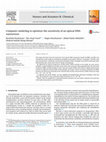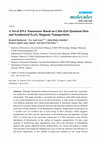Papers by Abdul Halim Bin Abdullah

tThis paper describes how the sensitivity of an optical DNA nanosensor based on MNPs and QDs wase... more tThis paper describes how the sensitivity of an optical DNA nanosensor based on MNPs and QDs wasenhanced by using computer simulations including an innovative software, Grasshopper. The data usedwas derived from a previously constructed mechanism which, although successful in detecting targetDNA qualitatively, raised some areas for further investigation.By adjusting the relative proportions of DNA probes, MNPs and QDs in the model, we were able tosimulate a range of different reactions in the sensor and to measure them quantitatively. We were ableto observe MNPs and QDs binding to more than one strand of DNA and to better understand how theynetwork in different concentrations of the solution. We found a direct correlation coefficient of 0.9666between the fluorescent intensity of the CdSe/ZnS QDs and the concentration of tDNA within the rangeof 1 × 10−6–3.9 × 10−9M.To optimize the sensor further, we also modified the hybridization procedure, breaking it into twosteps. This produced a very satisfactory LOD calculation of 1.75 × 10−9M.Finally, when we applied the 2 step hybridization procedure we were able to improve the sensitivityof the optical nanosensor up to 20% furthur.

Although nanoparticle-enhanced biosensors have been extensively researched,
few studies have syst... more Although nanoparticle-enhanced biosensors have been extensively researched,
few studies have systematically characterized the roles of nanoparticles in enhancing biosensor
functionality. This paper describes a successful new method in which DNA binds directly
to iron oxide nanoparticles for use in an optical biosensor. A wide variety of nanoparticles
with different properties have found broad application in biosensors because their small
physical size presents unique chemical, physical, and electronic properties that are different
from those of bulk materials. Of all nanoparticles, magnetic nanoparticles are proving to be
a versatile tool, an excellent case in point being in DNA bioassays, where magnetic
nanoparticles are often used for optimization of the hybridization and separation of target
DNA. A critical step in the successful construction of a DNA biosensor is the efficient
attachment of biomolecules to the surface of magnetic nanoparticles. To date, most
methods of synthesizing these nanoparticles have led to the formation of hydrophobic
particles that require additional surface modifications. As a result, the surface to volume
ratio decreases and nonspecific bindings may occur so that the sensitivity and efficiency of
the device deteriorates. A new method of large-scale synthesis of iron oxide (Fe3O4)
OPEN ACCESS
Molecules 2014, 19 4356
nanoparticles which results in the magnetite particles being in aqueous phase, was employed
in this study. Small modifications were applied to design an optical DNA nanosensor based
on sandwich hybridization. Characterization of the synthesized particles was carried out using
a variety of techniques and CdSe/ZnS core-shell quantum dots were used as the reporter
markers in a spectrofluorophotometer. We showed conclusively that DNA binds to the surface
of ironoxide nanoparticles without further surface modifications and that these magnetic
nanoparticles can be efficiently utilized as biomolecule carriers in biosensing devices.






Uploads
Papers by Abdul Halim Bin Abdullah
few studies have systematically characterized the roles of nanoparticles in enhancing biosensor
functionality. This paper describes a successful new method in which DNA binds directly
to iron oxide nanoparticles for use in an optical biosensor. A wide variety of nanoparticles
with different properties have found broad application in biosensors because their small
physical size presents unique chemical, physical, and electronic properties that are different
from those of bulk materials. Of all nanoparticles, magnetic nanoparticles are proving to be
a versatile tool, an excellent case in point being in DNA bioassays, where magnetic
nanoparticles are often used for optimization of the hybridization and separation of target
DNA. A critical step in the successful construction of a DNA biosensor is the efficient
attachment of biomolecules to the surface of magnetic nanoparticles. To date, most
methods of synthesizing these nanoparticles have led to the formation of hydrophobic
particles that require additional surface modifications. As a result, the surface to volume
ratio decreases and nonspecific bindings may occur so that the sensitivity and efficiency of
the device deteriorates. A new method of large-scale synthesis of iron oxide (Fe3O4)
OPEN ACCESS
Molecules 2014, 19 4356
nanoparticles which results in the magnetite particles being in aqueous phase, was employed
in this study. Small modifications were applied to design an optical DNA nanosensor based
on sandwich hybridization. Characterization of the synthesized particles was carried out using
a variety of techniques and CdSe/ZnS core-shell quantum dots were used as the reporter
markers in a spectrofluorophotometer. We showed conclusively that DNA binds to the surface
of ironoxide nanoparticles without further surface modifications and that these magnetic
nanoparticles can be efficiently utilized as biomolecule carriers in biosensing devices.
few studies have systematically characterized the roles of nanoparticles in enhancing biosensor
functionality. This paper describes a successful new method in which DNA binds directly
to iron oxide nanoparticles for use in an optical biosensor. A wide variety of nanoparticles
with different properties have found broad application in biosensors because their small
physical size presents unique chemical, physical, and electronic properties that are different
from those of bulk materials. Of all nanoparticles, magnetic nanoparticles are proving to be
a versatile tool, an excellent case in point being in DNA bioassays, where magnetic
nanoparticles are often used for optimization of the hybridization and separation of target
DNA. A critical step in the successful construction of a DNA biosensor is the efficient
attachment of biomolecules to the surface of magnetic nanoparticles. To date, most
methods of synthesizing these nanoparticles have led to the formation of hydrophobic
particles that require additional surface modifications. As a result, the surface to volume
ratio decreases and nonspecific bindings may occur so that the sensitivity and efficiency of
the device deteriorates. A new method of large-scale synthesis of iron oxide (Fe3O4)
OPEN ACCESS
Molecules 2014, 19 4356
nanoparticles which results in the magnetite particles being in aqueous phase, was employed
in this study. Small modifications were applied to design an optical DNA nanosensor based
on sandwich hybridization. Characterization of the synthesized particles was carried out using
a variety of techniques and CdSe/ZnS core-shell quantum dots were used as the reporter
markers in a spectrofluorophotometer. We showed conclusively that DNA binds to the surface
of ironoxide nanoparticles without further surface modifications and that these magnetic
nanoparticles can be efficiently utilized as biomolecule carriers in biosensing devices.